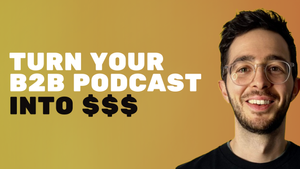Words can sell, and the art of making those words sell is called copywriting.
Ever wondered why some webpages make you reach for your wallet in the blink of an eye?
Or how a simple email, written just right, makes you click that button without a second thought?
Well, that's the power of copywriting, and today I'm going to teach you the basics so you can use it in your life science marketing and make more sales than you ever thought possible.
Let’s dive in.
What is copywriting?
Copywriting is the act of putting words on a page with the goal of convincing people to take a specific action.
Copywriting is a fundamental part of marketing AND communication.
It’s your emails, your website, your ads, your video script… basically everything you write to communicate has some form of copywriting in it.
Good copywriting is what makes people stay with you and give you their limited attention.
Let’s take the usual cold outreach email as an example.
What most marketers do is along these lines:
“Dear Mrs. A,
I’m from company X and we’d like to sell you something.
Our product is great, has the best features on the market and the best customer support. Please buy from us.”
You know these emails because everyone receives them.
And what do you do with them?
Yeah, you throw it in the trash because it’s asking you to buy something you don’t want.
Instead, here’s the kind of email you could have written with a little copywriting training:
“Hi Mrs. A,
I have found a way to help you save 55% on your lab budget.
I’m attaching to this email a detailed report on how to do this using a digital lab notebook. I found 3 vendors offering a great value and ease of implementation.
Email me back if you would like more recommendations.”
You see, this email doesn’t ask, instead, it gives without expecting anything in return.
That’s copywriting, an effective way to convert customers using simple, persuasive methods.
Now, let’s dive into six essential aspects of copywriting.
1. Focus on education
There is one big, counterintuitive thing about sales that most marketers ignore.
Our minds are wired for efficiency, and when we want to sell something, here’s how we naturally structure it:
- Sell the stuff
- Tell them why they should buy.
But there is a BIG problem with this method: Item 1 on the list will most likely send people running.
Imagine that you are managing a lab, and a salesperson comes knocking on your door.
The first words coming out of their mouth are: “Hey, you should really buy this new automated mass spectrometer. It’s super expensive but you should really invest in it, because it’s great!”.
Chances are you’ll find a way to get rid of this person, and fast.
Copywriting works because it uses a completely different approach:
- Spend 70% on providing helpful content
- Spend 30% selling.
Instead of jumping straight into the sales pitch, a good copywriter will spend most of her time creating content with real value.
Let’s go back to our example above.
Imagine that instead of coming to sell you something, the salesperson contacts you to offer a one-hour recommendation session on how to improve your lab setup.
This person knows all about the most efficient ways to run a lab on YOUR budget and offers to give you this experience for free.
At the end of the session, you will, of course, expect to be sold something, but that won’t bother you, because you’ve spent most of the time talking about YOUR lab and YOUR needs, so it feels natural to buy something based on those parameters.
That’s why copywriting is counterintuitive, we need to educate before we try to sell anything, and once you understand that, everything becomes much easier.
2. Write like you talk
This one will probably get me a few rolling eyes and maybe even make you leave this page, but give me a chance and listen to this:
You don’t have to write like an English teacher.
There is a kind of dark magic that happens every time you put a keyboard in front of someone in a business context: they start using complicated words and never-ending sentences.
Stop it, just write like a real person.
I can already hear you protesting, and telling me that life sciences marketing is different because we are talking to scientists, and scientists have superhuman brains that need Shakespearean prose to feel satisfied.
Wrong, scientists are just like everyone else (maybe a little more nerdy than the average).
And what they don't have is time to sit around trying to understand what your product page means.
So cut to the chase and make it simple.
The best way to do this is to imagine that you are talking to a friend while writing your copy.
Even if you’re talking about technical stuff with a friend, you won’t make it too complicated, so why not do the same with the people you’re actually trying to convince?
3. Use the “AIDA” formula
If you are remotely familiar with copywriting, you know that this is a synonym for supposedly magical formulas you can use to improve your copy and persuade people.
There are literally dozens of formulas, ranging from the “4 Ps” to some obscure ones like “HELLYEAH”.
But if you have to start somewhere and don’t want to get lost in a ton of complicated formulas, AIDA is your best bet and one that’s proven to work every time.
AIDA stands for:
- Attention
- Interest
- Desire
- Action.
Now let’s go through each step:
Attention
Grab the attention of your audience right from the start. This can be done through your headline, or through an important question you ask in your intro line. The important thing to understand is that the top of your copy should make someone want to read more, so don’t use complicated introductions and get to the point.
Interest
Engage your audience with interesting facts. Whether it’s some mind-blowing statistics or a really cool personal story, you need to keep their attention by using facts that speak to them.
Desire
Make them desire it. To accomplish this, make your audience understand the benefits of what you are trying to sell them in a very simple way. Desire works even better if you can provide proof of what you are saying by using data, testimonials, or a real case study.
Action
Make them take action, now. Give them a path to the next step in the most relevant way possible. Again, you’ll benefit greatly if this doesn’t look like a pure sales pitch, but instead invites your audience to get more of the good stuff you’re offering.
Let’s put this together into an example to show you what it means.
Let’s say I’m trying to sell you a piece of software to help you manage your lab waste.
(By the way, the information below is completely made up, so don’t try to verify it).
Here’s what AIDA would look like:
- Attention: “Did you know that managing your lab waste can take up to 15% of your budget if not done properly?”
- Interest: “Most labs are still using methods from the 80’s when it comes to waste management, resulting in more waste and higher costs to get rid of it.”
- Desire: “I use this simple piece of software to reduce waste in my lab by 50% without any effort thanks to automation.”
- Action: “My team and I researched the waste management process of 3 top labs and put their best practices into a free report that you can download here [+ link].”
This simple template works for pretty much anything, and is a great way to start practicing copywriting.
Later on, as your experience grows, you can explore more complex or specific formulas to improve your copywriting, but you’ll quickly see that AIDA is quite robust in any situation.
4. Write what people want
No one wants to read more than they have to, especially when it comes to buying something.
Good copywriting focuses on the key facts that people are already looking for, in order to preemptively answer their questions.
But how do you find out what people really want to know?
Fortunately, we have plenty of free tools to help you do that, and here are 3 of them:
Google is the best place to start because that’s where most people are likely searching for information.
What’s great about Google is that you can get a lot of information about what people are searching for without having to use complicated techniques or software.
All you have to do is scroll down to the bottom of a search page until you see the “Related search” section.
At the very bottom of this section is a list of frequently asked searches, which gives you a lot of information about what people are typing into the Google bar.
Here’s what it looks like when you search for “mass spectrometer”:
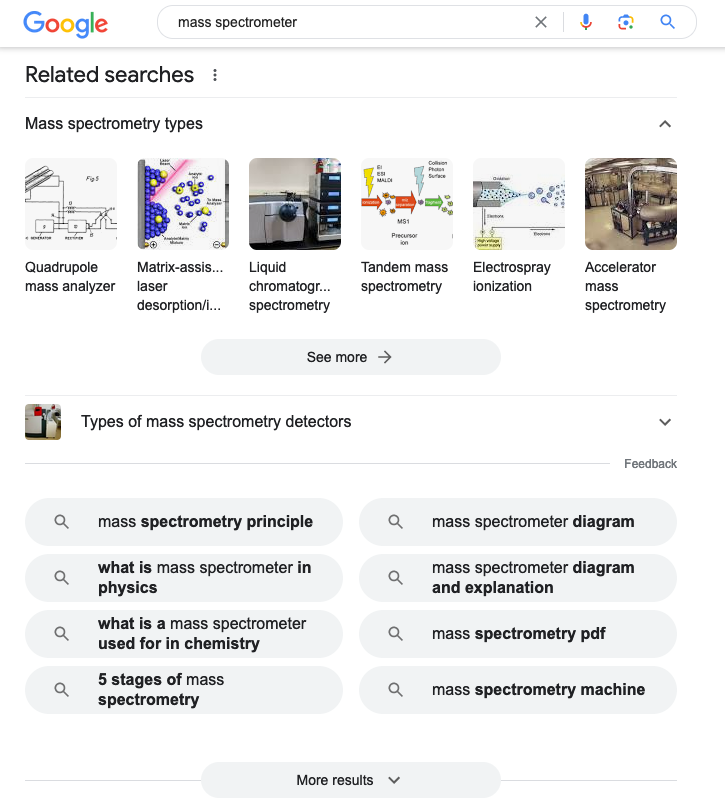
As you can see above, this already gives you a good idea of what to focus on if you sell mass spectrometers, but this term is quite general.
Fortunately, you can click on any of the suggestions and do the same process again.
Here’s what you get when you click on “mass spectrometer diagram”:
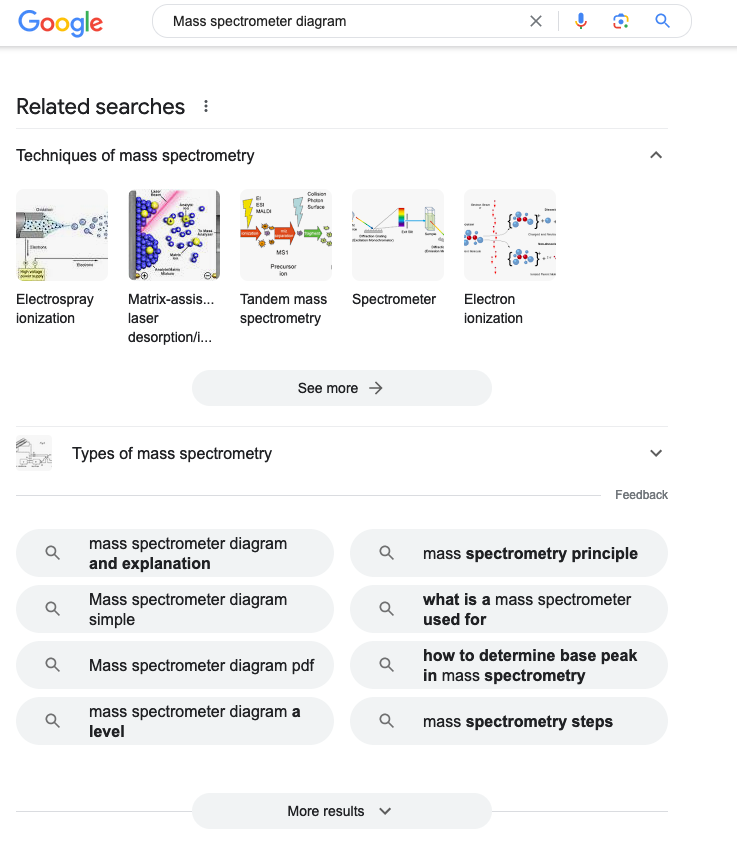
What you need to do is keep a list of all these terms and use them to build the outline of your copy.
If that is not enough, you have a few other options.
Quora
Quora is another great place to do the same kind of exercise.
Visit quora.com and type your keyword into the search bar.
Here’s our example again with “mass spectrometer”:
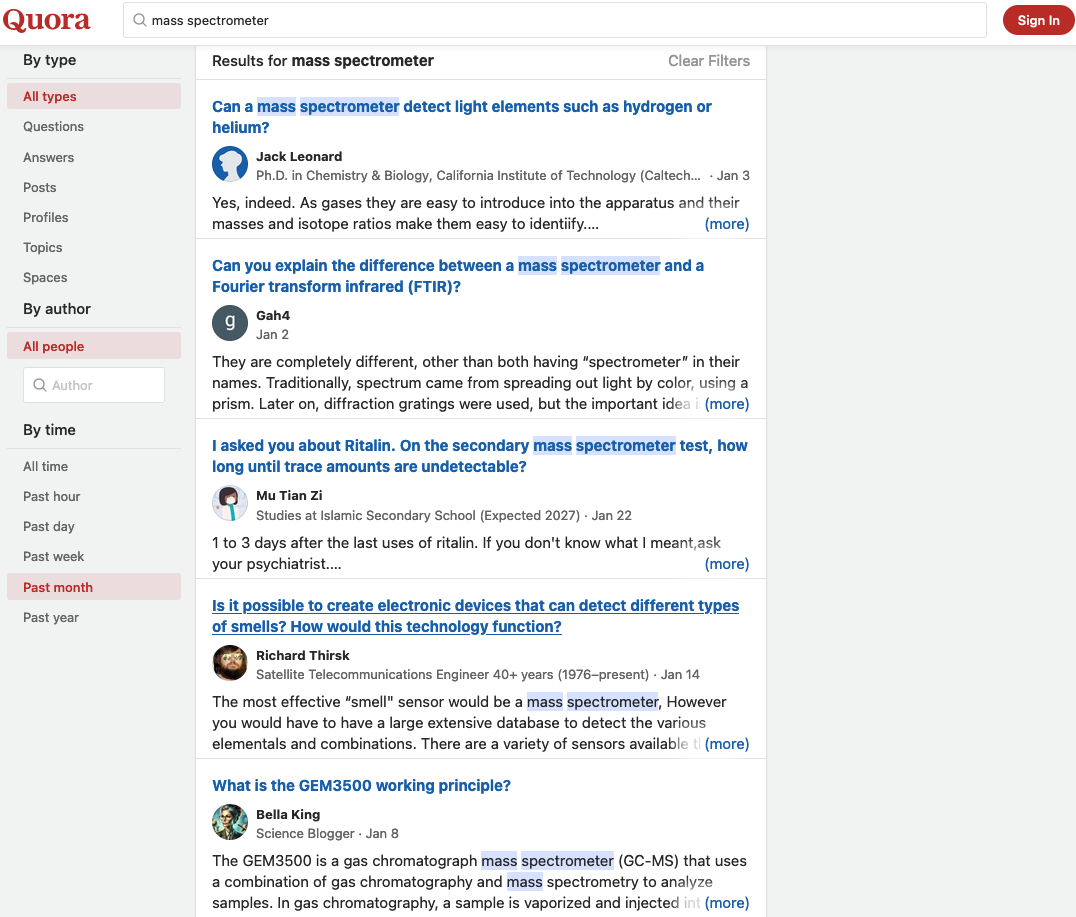
As you can see, you can get very specific questions that real people are asking, and answering them on your sales page can increase your chances of conversion.
Tips: Note that you can filter responses by time. Be sure to use this filter, as it usually gives more interesting results than the default “All time” option.
Similarly, you can go to Reddit.com and type in your keyword to find out what people are talking about.
Here’s the result for our example:
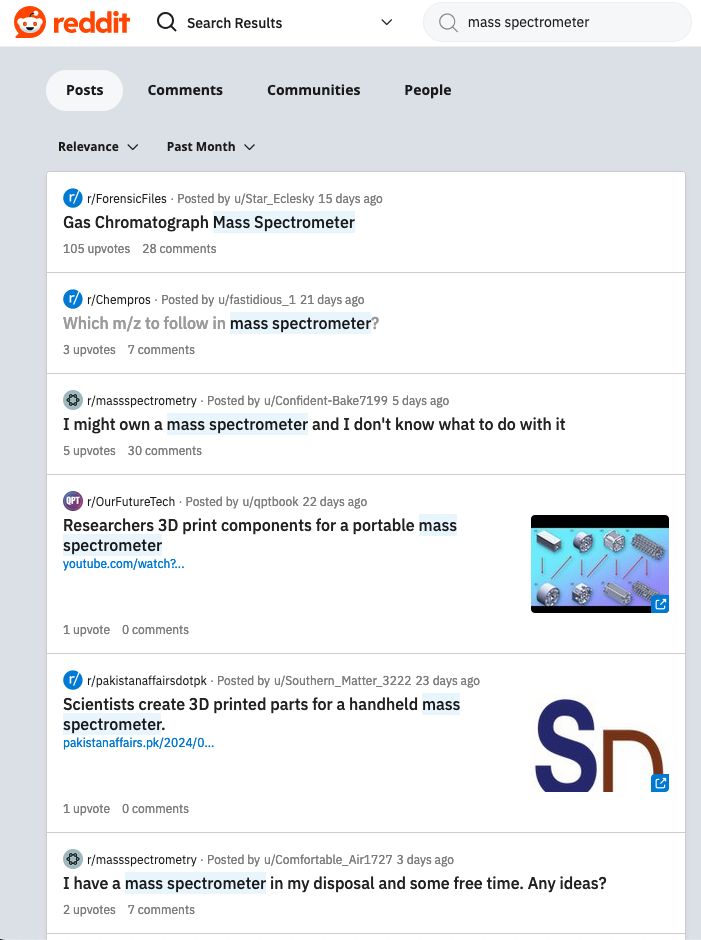
As with Quora, you can use filters to find more interesting results, so make sure to check them if what you get doesn’t seem relevant.
By using these three tools, you can figure out what’s the most important information that real people are looking for and include this in your copy.
This is a great way to increase conversions.
5. Explain benefits, not features
Marketers love to list a ton of features on their product page, but most of the time, they don’t really mean much if you don’t explain the benefits that your customers will get from them.
Let me show you an example of what this means.
Below are two examples of companies selling mass spectrometers (yes, I am obsessed with these machines).
One focuses its product page on features:
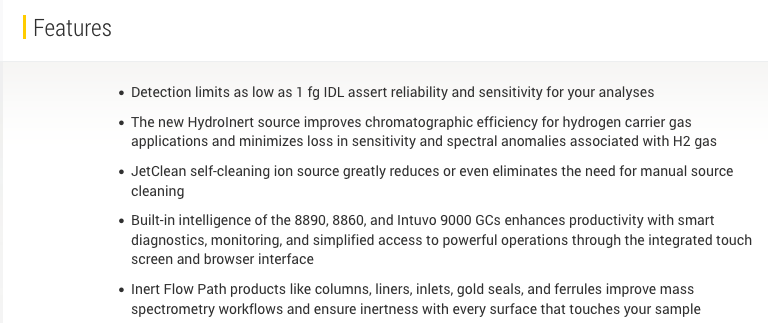
The other focuses on benefits:
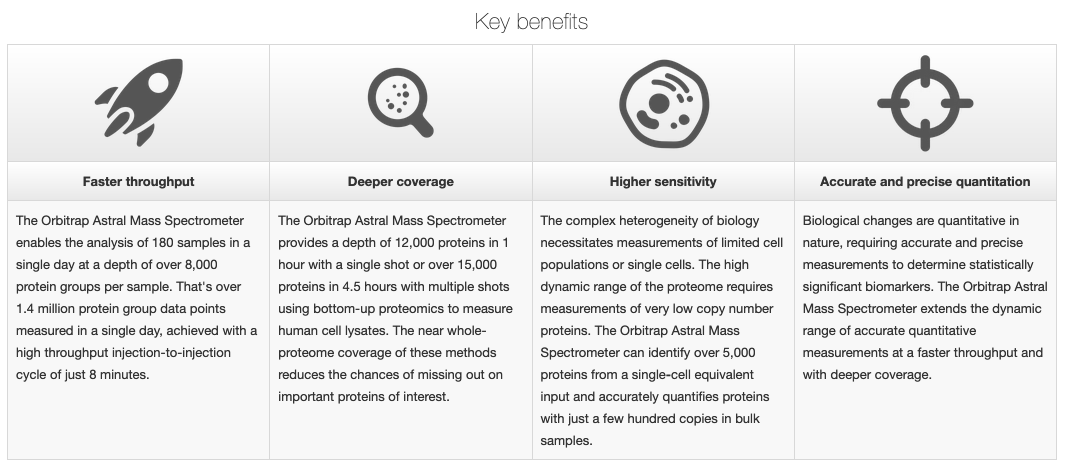
Which page appeals to you the most?
Unless you are a hardcore mass spectrometry nerd, chances are that the second page—the one focused on benefits—is more appealing to your eyes.
And that’s true for any product.
Let’s say you’re in the market for a new vacuum cleaner, and the product page tells you it has 300AW of suction power.
Does that mean anything to you?
Probably not.
But here is the key benefit of 300AW suction power: This thing will clean the hell out of your carpets!
Now you get it, right?
That’s why focusing on the benefits of your product, rather than simply listing features, is a key component of good copywriting.
6. Get to the point
Finally, one last piece of copywriting advice: it’s not about you!
Sorry to break it to you, but nobody cares about you or your company.
What people want to know when they come to your website is how you help THEM.
And if the first thing they see is a lengthy history of how your company came to be, chances are they will leave and not come back anytime soon.
Let’s take an example again, because I know you love them:
Company A
“Our company was established in 1987 by our esteemed founder, Professor X, to develop cutting-edge technologies. We strive to specialize in innovation-driven products and have extensive experience in the field with over 345 years of combined experience.”
Company B
“We make the most powerful mass spectrometer on the market. Period.”
See my point?
Landing on these two pages will likely result in very different reactions, and Company B’s conversion rate will crush Company A’s.
Less is more, especially in copywriting.
And the same goes for your call to action.
You need to make sure that your call to action is super obvious.
So don’t hide it in a dark corner of your page; make it big, colorful and right in their face.
The copywriting checklist
Okay, so let's put everything you've learned about copywriting today into a handy list that you can print out and keep on your desk:
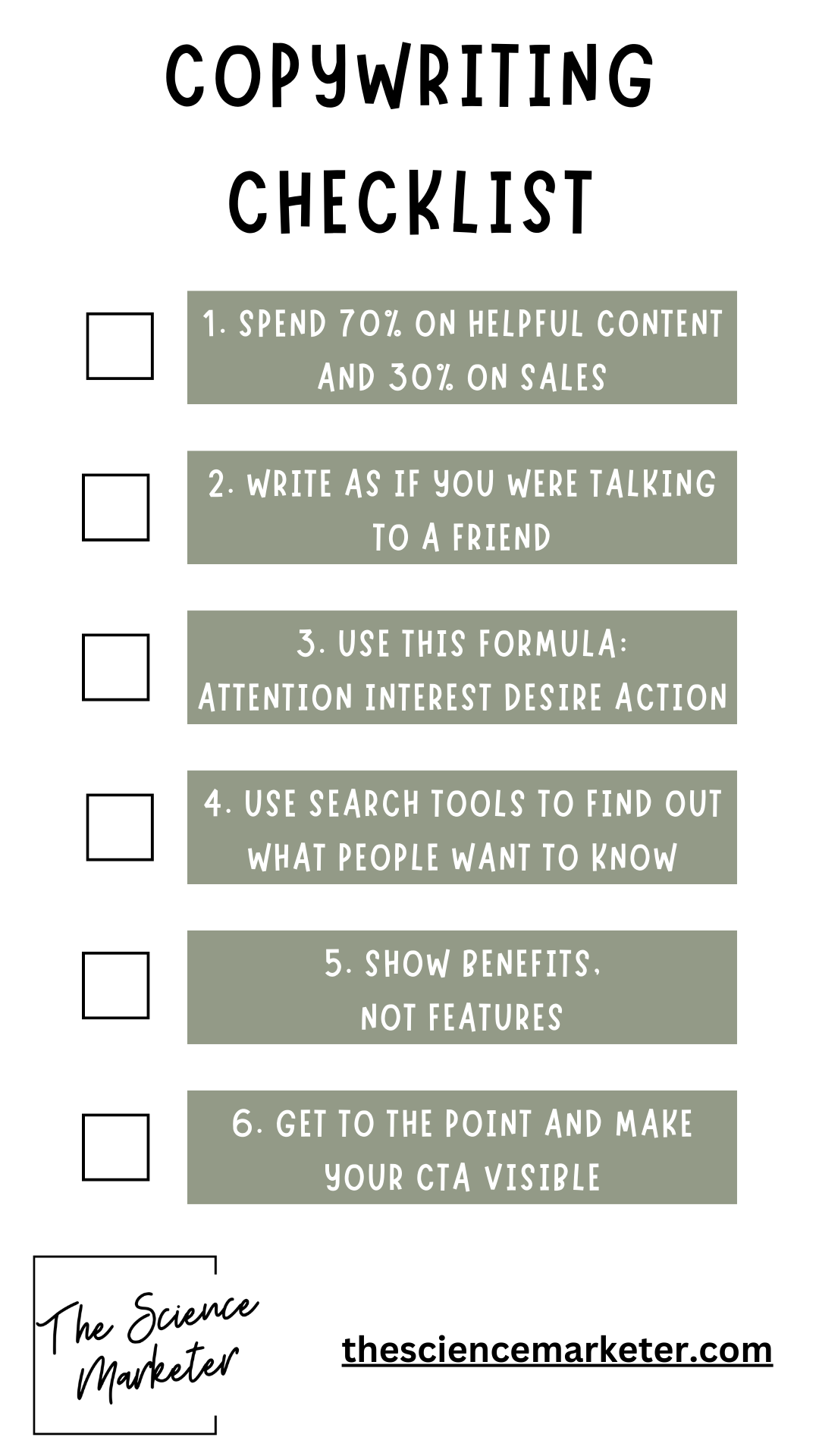
If you follow this list, you’ll already be ahead of 90% of other marketers.
And if you need more help with copywriting, contact me and we’ll talk about it together.






